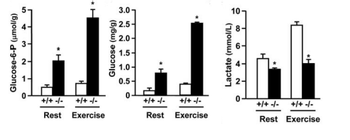
Glycogen storage disease type VII or Tarui disease is a rare, autosomal recessive muscular
glycogenosis characterized by exercise intolerance, rhabdomyolysis episodes, i.e., disintegration of
muscle associated with excretion of myoglobin in the urine, and hemolytic anemia, i.e., breakdown of
circulating erythrocytes with release of hemoglobin into plasma, generally revealed by laboratory tests.
The molecular origin of this disease is a deficiency of muscle PFK-1 with a partial deficiency of the
enzyme in erythrocytes. Important characterization of the
disease has been obtained by genetically generating mice with muscle PFK-1deficiency. The histogram diagrams below contrast levels of three glycolytic intermediates in skeletal muscle tissue of wild
type (+/+) normal mice with that in PFK-1 deficient (-/-) mice during rest and exercise. Using the
material discussed in the previous parts of this question, discuss why lactate concentrations in the
PFK-1 deficient mice do not change significantly during exercise in comparison to wild type mice.

Trending nowThis is a popular solution!
Step by stepSolved in 3 steps

- One of the following choices is INCORRECT Glycated haemoglobin is reported as mmol HbA1c divided by mmol of total haemoglobin Galactosemia is due to the deficiency of galactose-1-phoasphatase The adequacy of dialysis is usually assessed by predialysis and postdialysis measurement of urea Individuals with a recent significant blood loss have truly low values of HbA1c Both B and D A, B and C None of the above When a person has which of the following fasting blood glucose levels is considered as prediabetic or having an insulin resistance? 50 mg/dL (2.75 mmol/L) 65 mg/dL (3.61 mmol/L) 70 mg/dL (3.89 mmol/L) 121 mg/dL (6.71 mmol/L) None of the abovearrow_forwardnormal misfolded amyloid fibril Figure 3.15A The accompanying figure shows the misfolding of the PrPC protein that occurs in varlant Creutzfeldt-Jakob disease (VCJD). The misfolding affects the structure of the normal protein.arrow_forwardExplain the functional changes in the Crohn's disease process that led to patient's weight lossarrow_forward
- A mitochondrial matrix protein is maintained in its unfolded state by a chaperone protein before transport across the mitochondrial membrane true falsearrow_forwardMatch the bold specific genetic metabolic disorders to their category: adrenal hyperplasia Albinism Cystinuria Galactosaemia Phenylketonuria Pompe Wilson Disease Chromosomal abnormality Excessive amounts of metabolites in a metabolic pathway Storage disease Disrupted regulatory system Disrupted Vitamin and/or co-factor absorption or processing Transport disorder Accumulation of substrates in a metabolic pathway Absence of end productarrow_forwardAll but one of the following statements are true: Megaloblastic anemia is characterized by abnormally large immature red blood cells with no nuclei. Impaired DNA synthesis arrests cell division, blocking the full maturation of red blood cells. Symptoms of megaloblastic anemia include fatigue, pale skin, and muscle weakness. Megaloblastic anemia occurs with either a folate or a B12 deficiency, disrupting DNA synthesis.arrow_forward
- Nearly all immune deficiency diseases that result in impaired TH17 and ILC3 function lead to chronic mucocutaneous candidiasis (CMC), usually accompanied by increased susceptibility to pyogenic bacterial infections. However, a subset of these patients also show increased susceptibility to intracellular bacterial infections, such as those caused by Mycobacteria species. What is the explanation for why some, but not all, of these patients have increased susceptibility to intracellular bacteria and which patients fall into this category?arrow_forwardTumor necrosis factor (TNF) signaling Discuss how Rheumatoid Arthritis is caused when the pathway is inappropriately activated or not functioning properly, provide one other reference than the photo below to expand on how the signaling pathway is disrupted.arrow_forwardRegarding cardiovascular disease, match each tern A condition marked by edema of the lungs and shortness of breath, especially when lying down A lesion often seen on the retinal surface (in the eye) of people with diabetes and/or hypertension A triglyceride produced in the liver in response to a high carbohydrate diet that increases chronic disease risk A macrophage that has become engorged with indigestible lipid molecules, leading to inflammation [Choose ] [Choose ] [Choose ] [Choose ] the phrase best describes itarrow_forward
- A young female patient presents in the clinic with pallor and fatigue. History reveals a switch to vegetarianism last year along with a little weight loss. Blood results show a hemoglobin value of 65 g/L and a hematocrit of 0.29. Which of the following is most likely the cause of her symptoms? Question 46 options: a) Covert iron deficiency b) Primary iron deficiency c) A secondary deficiency of iron d) A subclinical iron deficiencyarrow_forwardThe ABO blood group antigens are the terminal sugars covalently linked to the end of the glycolipid in the red blood cellmembrane. The H antigen is the precursor of the A and Bantigens. Individuals with type A blood produce a gene thatcodes for an enzyme that adds N-acetylgalactosamine in ana(1,3) linkage to the Gal* residue in the H antigen. Type Bblood requires that an enzyme add a d-a galactose in an a(1,3) linkage to the Gal*. Draw the structures of the A andB antigens.arrow_forwardDetail the molecular pathophysiology that leads to cystic fibrosis-related diabetes.arrow_forward
 BiochemistryBiochemistryISBN:9781319114671Author:Lubert Stryer, Jeremy M. Berg, John L. Tymoczko, Gregory J. Gatto Jr.Publisher:W. H. Freeman
BiochemistryBiochemistryISBN:9781319114671Author:Lubert Stryer, Jeremy M. Berg, John L. Tymoczko, Gregory J. Gatto Jr.Publisher:W. H. Freeman Lehninger Principles of BiochemistryBiochemistryISBN:9781464126116Author:David L. Nelson, Michael M. CoxPublisher:W. H. Freeman
Lehninger Principles of BiochemistryBiochemistryISBN:9781464126116Author:David L. Nelson, Michael M. CoxPublisher:W. H. Freeman Fundamentals of Biochemistry: Life at the Molecul...BiochemistryISBN:9781118918401Author:Donald Voet, Judith G. Voet, Charlotte W. PrattPublisher:WILEY
Fundamentals of Biochemistry: Life at the Molecul...BiochemistryISBN:9781118918401Author:Donald Voet, Judith G. Voet, Charlotte W. PrattPublisher:WILEY BiochemistryBiochemistryISBN:9781305961135Author:Mary K. Campbell, Shawn O. Farrell, Owen M. McDougalPublisher:Cengage Learning
BiochemistryBiochemistryISBN:9781305961135Author:Mary K. Campbell, Shawn O. Farrell, Owen M. McDougalPublisher:Cengage Learning BiochemistryBiochemistryISBN:9781305577206Author:Reginald H. Garrett, Charles M. GrishamPublisher:Cengage Learning
BiochemistryBiochemistryISBN:9781305577206Author:Reginald H. Garrett, Charles M. GrishamPublisher:Cengage Learning Fundamentals of General, Organic, and Biological ...BiochemistryISBN:9780134015187Author:John E. McMurry, David S. Ballantine, Carl A. Hoeger, Virginia E. PetersonPublisher:PEARSON
Fundamentals of General, Organic, and Biological ...BiochemistryISBN:9780134015187Author:John E. McMurry, David S. Ballantine, Carl A. Hoeger, Virginia E. PetersonPublisher:PEARSON





